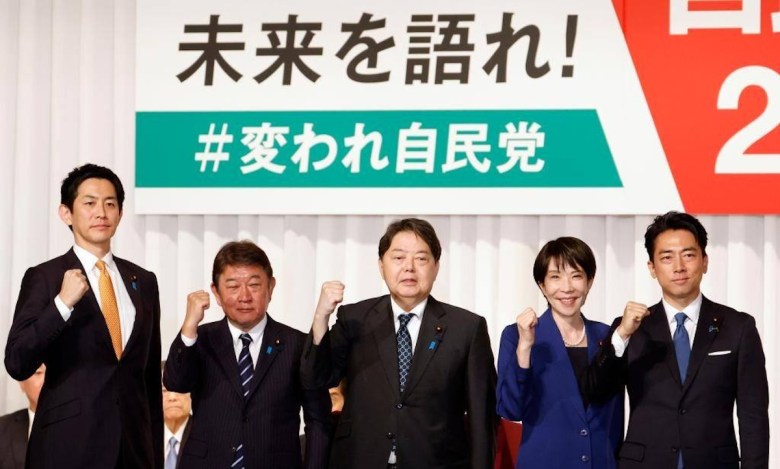Top Stories
Candidates Show Diverging Paths in Japan’s LDP Leadership Contest

The race to lead Japan’s long-standing Liberal Democratic Party (LDP) has entered a pivotal phase, marked by varied approaches among candidates vying for the prime ministership. As the initial series of public events and debates conclude, it is evident that Sanae Takaichi stands out as the sole candidate willing to take bold positions, setting her apart from the other contenders.
Takaichi’s fiscal policy proposals include an openness to utilizing deficit bonds for stimulus spending. She expresses skepticism about an immediate reduction in the consumption tax, although she is amenable to discussing adjustments in the medium term. Her critical comments regarding the Bank of Japan’s recent announcement to offload ETF and REIT holdings reflect her willingness to challenge the status quo. Takaichi has also advocated for expedited coalition negotiations before a new government is confirmed by the Diet, Japan’s national legislature. Furthermore, her more assertive stance on Japan’s foreign population and over-tourism has drawn both attention and criticism.
In contrast, the other four candidates—Takayuki Kobayashi, Shinjiro Koizumi, Toshimitsu Motegi, and Yoshimasa Hayashi—have generally adopted more cautious positions. All candidates acknowledge the necessity of demonstrating swift government action to address public concerns. They emphasize the importance of building a strong team while seeking new coalition partners. Notably, there is a consensus that a snap election is not imminent, and while there is enthusiasm around passing a supplemental budget that includes proposals from opposition parties, none support an immediate consumption tax cut.
The candidates uniformly recognize the challenging international environment Japan faces and agree on the need to increase defense spending, yet they refrain from specifying how much or how such increases should be financed. Each candidate has remained true to their political branding, showcasing impressive message discipline. Takaichi embodies conservative values, while Kobayashi emphasizes youth engagement. Koizumi focuses on the cost-of-living crisis, and both Motegi and Hayashi highlight their experience and leadership capabilities.
These dynamics have led to what some commentators describe as a sluggish campaign. Journalist Izumi Hiroshi notes the lack of friction in debates, while the publication Nikkan Gendai has characterized the campaign as “guda guda,” a term meaning worn out or sluggish. Attendance at candidate rallies, such as the one held at Akihabara Station, has been sparse, and no candidate appears eager to challenge the others aggressively.
As the candidates discuss their potential relationships with the administration of U.S. President Donald Trump, their responses lack sophistication. During a recent debate at the National Press Club, Motegi pressed Koizumi for a specific strategy regarding Trump, to which Koizumi responded that he would prioritize meeting Trump to establish a trust-based relationship. Motegi has reiterated his aim to pursue tariff reductions with the U.S., but such ambitions appear unrealistic under current circumstances.
A recent poll conducted by Nippon TV on September 25 shows a shift in support among LDP backers. Takaichi gained six percentage points, bringing her to 34%, surpassing Koizumi, who fell to 28%. Hayashi also saw a modest increase to 17%, slightly closing the gap with the frontrunners. This data, analyzed using a d’Hondt method calculator, suggests potential vote splits that could influence the outcome of the election scheduled for October 4, 2023.
While one poll does not definitively signal trouble for Koizumi, his declining support raises concerns, particularly in light of his previous struggles last year that prevented him from advancing to the runoff. He may also face negative press following reports that Karen Makishima, an LDP lawmaker and part of Koizumi’s campaign, encouraged supporters to generate positive online comments during a public appearance. Despite his strong backing among lawmakers, a decline in public support could sway undecided representatives, of which there are still 107 out of 295.
As coalition talks loom, former prime minister Yoshihide Suga met with Takashi Endo, the parliamentary affairs chief of Ishin no Kai, on September 24. Such discussions are essential as the LDP seeks to establish a new coalition partner. Although Takaichi advocates for concluding coalition negotiations before the new government takes office, the timing remains uncertain, particularly with the upcoming Diet session expected to select a new prime minister.
In the coming weeks, communication between candidates and opposition parties is anticipated as the LDP navigates the complexities of coalition-building and policy alignment. This political landscape will continue to evolve as the October 4 election approaches, shaping the future direction of Japan’s leadership.
-

 Business5 months ago
Business5 months agoKenvue Dismisses CEO Thibaut Mongon as Strategic Review Advances
-

 Lifestyle4 months ago
Lifestyle4 months agoHumanism Camp Engages 250 Youths in Summer Fest 2025
-

 Sports4 months ago
Sports4 months agoDe Minaur Triumphs at Washington Open After Thrilling Comeback
-

 Sports5 months ago
Sports5 months agoTupou and Daugunu Join First Nations Squad for Lions Clash
-

 Top Stories5 months ago
Top Stories5 months agoColombian Senator Miguel Uribe Shows Signs of Recovery After Attack
-

 World5 months ago
World5 months agoASEAN Gears Up for Historic Joint Meeting of Foreign and Economic Ministers
-

 Health4 months ago
Health4 months agoNew Study Challenges Assumptions About Aging and Inflammation
-

 Business5 months ago
Business5 months agoOil Prices Surge Following New EU Sanctions on Russia
-

 Entertainment4 months ago
Entertainment4 months agoDetaşe-Sabah Violin Ensemble Captivates at Gabala Music Festival
-

 Entertainment4 months ago
Entertainment4 months agoBaku Metro Extends Hours for Justin Timberlake Concert
-

 Top Stories5 months ago
Top Stories5 months agoRethinking Singapore’s F&B Regulations Amid Business Closures
-

 Business5 months ago
Business5 months agoU.S. House Approves Stablecoin Bill, Sends to Trump for Signature









